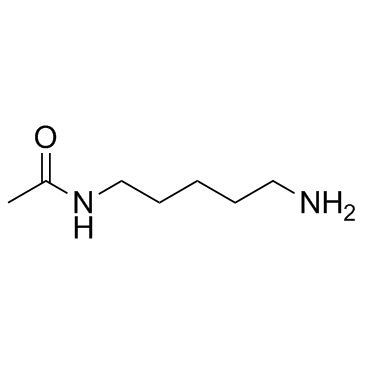
N-(5-Aminopentyl)acetamide
CAS No. 32343-73-0
N-(5-Aminopentyl)acetamide ( Monoacetylcadaverine | N-Acetyl-15-pentanediamine | N-Acetylcadaverine )
产品货号. M19992 CAS No. 32343-73-0
N-乙酰尸胺是多胺尸胺的乙酰化形式。尸胺是由活体和死亡生物体内的氨基酸分解产生的,大剂量时有毒。 N-(5-氨基戊基)乙酰胺是一种有前途的癌症和许多其他病理生理状况的生化标志物。
纯度: >98% (HPLC)
 COA
COA
 Datasheet
Datasheet
 HNMR
HNMR
 HPLC
HPLC
 MSDS
MSDS
 Handing Instructions
Handing Instructions
| 规格 | 价格/人民币 | 库存 | 数量 |
| 100MG | ¥551 | 有现货 |


|
| 200MG | 获取报价 | 有现货 |


|
| 500MG | 获取报价 | 有现货 |


|
| 1G | 获取报价 | 有现货 |


|
生物学信息
-
产品名称N-(5-Aminopentyl)acetamide
-
注意事项本公司产品仅用于科研实验,不得用于人体或动物的临床与诊断
-
产品简述N-乙酰尸胺是多胺尸胺的乙酰化形式。尸胺是由活体和死亡生物体内的氨基酸分解产生的,大剂量时有毒。 N-(5-氨基戊基)乙酰胺是一种有前途的癌症和许多其他病理生理状况的生化标志物。
-
产品描述N-Acetylcadaverine is the acetylated form of the polyamine cadaverine. Cadaverine is produced by the breakdown of amino acids in living and dead organisms and is toxic in large doses. N-(5-Aminopentyl)acetamide is a promising biochemical marker for cancer and many other pathophysiological conditions.
-
体外实验Polyamine is a small organic polycation composed of a hydrocarbon backbone with multiple amino groups which ubiquitously exists in all living organisms from bacteria to higher animals. The critical step of polyamine biosynthesis generally includes the amino acid-decarboxylating reaction to produce the primary diamines, such as cadaverine from lysine. Synthesized polyamines are implicated in a wide variety of cytoplasmic reactions such as DNA replication and protein synthesis, and are essential for proper growth and proliferation of the organisms. Cadaverine is a linear molecule that terminate at both ends with an amine functional group. These functional groups confer to the molecules multiple positive charges at physiological pH. Cadaverine is produced through the action of basic amino acid decarboxylases and is found associated with the outer membrane.
-
体内实验——
-
同义词Monoacetylcadaverine | N-Acetyl-15-pentanediamine | N-Acetylcadaverine
-
通路Others
-
靶点Other Targets
-
受体Others
-
研究领域——
-
适应症——
化学信息
-
CAS Number32343-73-0
-
分子量144.21
-
分子式C7H16N2O
-
纯度>98% (HPLC)
-
溶解度DMSO: 25 mg/mL
-
SMILESCC(=O)NCCCCCN
-
化学全称——
运输与储存
-
储存条件(-20℃)
-
运输条件With Ice Pack
-
稳定性≥ 2 years
参考文献
1.Paik MJ et al. Urinary polyamines and N-acetylated polyamines in four patients with Alzheimer's disease as their N-ethoxycarbonyl-N-pentafluoropropionyl derivatives by gas chromatography-mass spectrometry in selected ion monitoring mode. Anal Chim Acta. 2006 Aug 18;576(1):55-60.
产品手册




关联产品
-
Isorhamnetin 3-robin...
Isorhamnetin 3-O-robinobioside 对人慢性粒细胞白血病细胞系 K562 具有强大的抗氧化和抗原毒性潜力。
-
[Ala13] - Apelin - 1...
[Ala13] - Apelin - 13
-
Plantagoside
Plantagoside 是刀豆 α-甘露糖苷酶的特异性非竞争性抑制剂 (IC50: 5 μM)。它也是美拉德反应的有效抑制剂。



 021-51111890
021-51111890 购物车()
购物车()
 sales@molnova.cn
sales@molnova.cn







